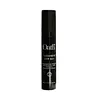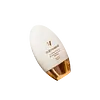What's inside
What's inside
 Key Ingredients
Key Ingredients

 Benefits
Benefits

 Concerns
Concerns

No concerns
 Ingredients Side-by-side
Ingredients Side-by-side

Zinc Oxide 14.7%
Cosmetic ColorantTitanium Dioxide 3.5%
Cosmetic ColorantCyclopentasiloxane
EmollientCyclomethicone
EmollientDimethicone Crosspolymer
Emulsion StabilisingMethyl Methacrylate/Glycol Dimethacrylate Crosspolymer
Dimethicone/Vinyl Dimethicone Crosspolymer
Skin ConditioningMelanin
Skin ProtectingTribehenin
EmollientCalcium Behenate
Sorbitan Isostearate
EmulsifyingDimethiconol
EmollientAlumina
AbrasivePEG-10 Dimethicone
Skin ConditioningTocopheryl Linoleate
AntioxidantMyristoyl Pentapeptide-17
Skin ConditioningMethicone
EmollientMyristoyl Nonapeptide-3
Skin ConditioningAscorbyl Linoleate
AntioxidantIron Oxides
Cholecalciferol
Lycopene
AntioxidantGlycerin
HumectantSucrose Palmitate
EmollientLecithin
EmollientZinc Oxide 14.7%, Titanium Dioxide 3.5%, Cyclopentasiloxane, Cyclomethicone, Dimethicone Crosspolymer, Methyl Methacrylate/Glycol Dimethacrylate Crosspolymer, Dimethicone/Vinyl Dimethicone Crosspolymer, Melanin, Tribehenin, Calcium Behenate, Sorbitan Isostearate, Dimethiconol, Alumina, PEG-10 Dimethicone, Tocopheryl Linoleate, Myristoyl Pentapeptide-17, Methicone, Myristoyl Nonapeptide-3, Ascorbyl Linoleate, Iron Oxides, Cholecalciferol, Lycopene, Glycerin, Sucrose Palmitate, Lecithin
Water
Skin ConditioningZinc Oxide 17%
Cosmetic ColorantC12-15 Alkyl Benzoate
AntimicrobialButyloctyl Salicylate
Skin ConditioningCaprylyl Methicone
Skin ConditioningGlycerin
HumectantDimethicone
EmollientNiacinamide
SmoothingCopernicia Cerifera Wax
Argania Spinosa Kernel Oil
EmollientTocopheryl Acetate
AntioxidantPEG-9 Polydimethylsiloxyethyl Dimethicone
EmulsifyingCapsicum Annuum Fruit Extract
AntimicrobialPolyhydroxystearic Acid
EmulsifyingDimethicone/PEG-10/15 Crosspolymer
Stearalkonium Hectorite
Gel FormingTocopherol
AntioxidantPhenoxyethanol
PreservativeSodium PCA
HumectantBuddleja Davidii Callus Extract
Dimethicone/Vinyl Dimethicone Crosspolymer
Skin ConditioningPropylene Carbonate
SolventIsostearic Acid
CleansingOryza Sativa Bran Wax
Skin ConditioningBisabolol
MaskingDisodium EDTA
Citric Acid
BufferingDipropylene Glycol
HumectantSodium Benzoate
MaskingXanthan Gum
EmulsifyingSodium Citrate
BufferingSodium Salicylate
PreservativeWater, Zinc Oxide 17%, C12-15 Alkyl Benzoate, Butyloctyl Salicylate, Caprylyl Methicone, Glycerin, Dimethicone, Niacinamide, Copernicia Cerifera Wax, Argania Spinosa Kernel Oil, Tocopheryl Acetate, PEG-9 Polydimethylsiloxyethyl Dimethicone, Capsicum Annuum Fruit Extract, Polyhydroxystearic Acid, Dimethicone/PEG-10/15 Crosspolymer, Stearalkonium Hectorite, Tocopherol, Phenoxyethanol, Sodium PCA, Buddleja Davidii Callus Extract, Dimethicone/Vinyl Dimethicone Crosspolymer, Propylene Carbonate, Isostearic Acid, Oryza Sativa Bran Wax, Bisabolol, Disodium EDTA, Citric Acid, Dipropylene Glycol, Sodium Benzoate, Xanthan Gum, Sodium Citrate, Sodium Salicylate
Ingredients Explained
These ingredients are found in both products.
Ingredients higher up in an ingredient list are typically present in a larger amount.
This ingredient is a silicone used to improve the texture of products and absorb oil. It does not get absorbed into the skin.
Like other silicones, Dimethicone/Vinyl Dimethicone Crosspolymer helps condition the skin by creating a barrier. In this sense, it can act as an emollient and trap moisture in.
This ingredient is a type of elastomer.
Learn more about Dimethicone/Vinyl Dimethicone CrosspolymerGlycerin is already naturally found in your skin. It helps moisturize and protect your skin.
A study from 2016 found glycerin to be more effective as a humectant than AHAs and hyaluronic acid.
As a humectant, it helps the skin stay hydrated by pulling moisture to your skin. The low molecular weight of glycerin allows it to pull moisture into the deeper layers of your skin.
Hydrated skin improves your skin barrier; Your skin barrier helps protect against irritants and bacteria.
Glycerin has also been found to have antimicrobial and antiviral properties. Due to these properties, glycerin is often used in wound and burn treatments.
In cosmetics, glycerin is usually derived from plants such as soybean or palm. However, it can also be sourced from animals, such as tallow or animal fat.
This ingredient is organic, colorless, odorless, and non-toxic.
Glycerin is the name for this ingredient in American English. British English uses Glycerol/Glycerine.
Learn more about GlycerinZinc Oxide is a mineral broad-spectrum UV filter; it is the broadest UVA and UVB reflector approved by the FDA. It also has skin protectant and skin soothing properties.
Zinc oxide is one of the most effective broad-spectrum UV filters. It protects against UVB, UVAII, and UVAI. In comparison to its counterpart titanium dioxide, zinc oxide provides uniform and extended UVA protection.
Another great benefit? This ingredient is highly photostable so it won't degrade easily under sunlight.
A common myth is that mineral UV filters are widely believed to primarily reflect UV light.
However, modern research shows titanium dioxide absorbs UV radiation like chemical filters (~95% absorption & 5% reflection).
Zinc oxide has great skin soothing properties so you'll likely find this in sunscreens formulated for sensitive skin or babies/children. It is unlikely to cause "eye sting" like other sunscreen ingredients.
Regulatory agencies consider zinc oxide to be non-toxic and safe. It has also been shown to not penetrate the skin.
Unfortunately, this ingredient does leave a visible white cast. This is why mineral sunscreens are often less cosmetically elegant than chemical or hybrid ones.
In cosmetics, zinc oxide can be found in both non-nano and nano-sized forms. The nano version is used to reduce white cast and improve the texture of sunscreen formulas.
There are ongoing concerns surrounding nano-zinc oxide's impact on marine ecosystems and whether it can be absorbed into skin.
Regarding marine ecosystems and coral reefs, there is no conclusive evidence that any form of zinc oxide (or any other sunscreen ingredients) will cause harm. The science is still developing but many consumers are keeping a close eye on this issue.
Please note, many destinations have reef-safety sunscreen rules. For instance, the U.S. Virgin Islands advises all visitors to use non-nano mineral sunscreens.
There has also been some stir about whether micronized or nano zinc oxide has potential photoxicity and absorption through the skin/lungs.
An in-vitro (done in a test tube or petri dish) study demonstrated micronized zinc oxide to have potential phototoxicity. There's no need to fret; the EU Commission's Scientific Committee on Consumer Safety has stated, "The relevance of these findings needs to be clarified by appropriate investigations in vivo." Or in other words, further studies done on living organisms are needed to prove this.
Current research shows zinc oxide nanoparticles do not penetrate intact or sunburned skin. They either remain on the surface or in the outermost layer of dead skin (stratum corneum).
Zinc oxide is one of only two classified mineral UV filters with titanium dioxide being the other one.
Fun fact: Zinc has been used throughout history as an ingredient in paint and medicine. An Indian text from 500BC is believed to list zinc oxide as a salve for open wound. The Ancient Greek physician Dioscorides has also mentioned the use of zinc as an ointment in 1AD.
Learn more about Zinc Oxide